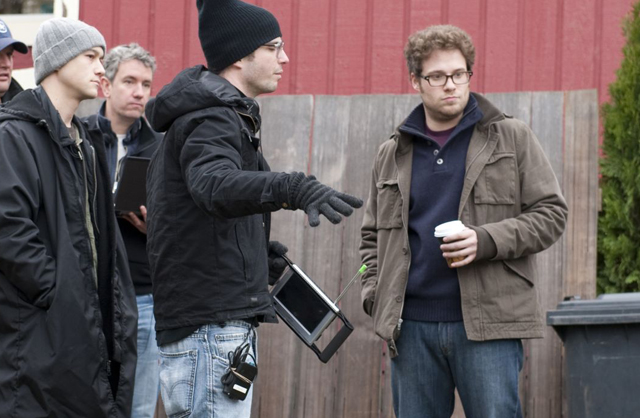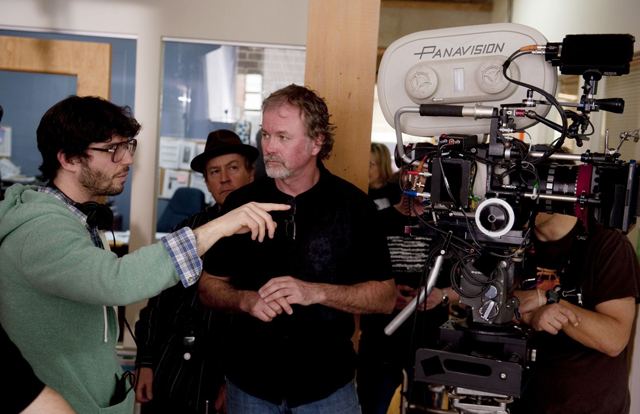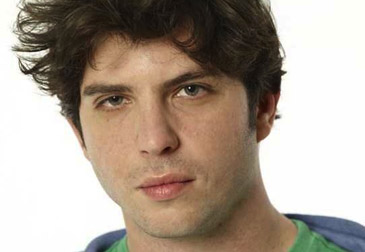CHICAGO – Patrick McDonald of HollywoodChicago.com appears on “The Morning Mess” with Dan Baker on WBGR-FM (Monroe, Wisconsin) on March 21st, 2024, reviewing the new streaming series “Manhunt” – based on the bestseller by James L. Swanson – currently streaming on Apple TV+.
Interview: ‘50/50’ Director Jonathan Levine Appears at CineYouth Festival in Chicago
CHICAGO – Thursday, May 31st, marks the beginning of the CineYouth Festival, sponsored by the Chicago International Film Festival. And what better way to kick it off than with a Q&A featuring director Jonathan Levine, coming off of his 2011 hit film, “50/50.” The appearance will take place at the AMC River East 21 Theater in Chicago.
Levine began his career with a short film called “Shards” in 2004, and then broke out with his feature debut, “All the Boys Love Mandy Lane” in 2006. He followed that up with “The Wackness” – starring Ben Kingsley and Josh Peck – two years later, which he directed from his own screenplay. It was a chance letter to the production team of “50/50” that got him that film, and the poignant comedy was a notable hit in 2011. Levine has just finished post-production for “Warm Bodies,” which is scheduled to be released next year.
 Photo credit: Chris Helcermanas-Benge for Summit Entertainment |
The CineYouth Festival celebrates younger filmmakers – 21 years old and under – and is part of the year round activities of the Chicago International Film Festival. The festival runs from Thursday, May 31st through Saturday, June 2nd with workshops, panel discussions, screenings and awards ceremony. In anticipation of his appearance at the festival’s opening night, Jonathan Levine talked to HollywoodChicago.com via phone from Los Angeles.
HollywoodChicago.com: Why is it important for you to make an appearance on behalf of the CineYouth festival?
Jonathan Levine: I often made movies that are more sophisticated for younger people. Those are the people who I’m talking to in the making of films. Beyond that, I knew I wanted to be a filmmaker from a very early age, and I didn’t have many resources available. So this is a good opportunity to talk to young people and be a resource for them.
HollywoodChicago.com: What was your breakthrough moment as a young filmmaker, the moment you knew that everything could possibly change and evolve your career?
Levine: When I made ‘All the Boys Love Mandy Lane’ in 2006, and presented it at the Toronto Film Festival. The screening that night ignited a bidding war, and I thought it was a practical joke that people wanted to buy the movie. I felt my life kind of change, that was my movie moment night.
HollywoodChicago.com: You have done two films from your own screenplays, and two with other writers. What are the essential differences in a directorial approach between working from your own screenplay versus working with another person’s adaptation?
Levine: I don’t approach the material any differently, although I think there are far more pitfalls when you’re writing a film yourself. From my perspective, when I approach a scene, as in how the actors will directed and shot, that is all the same whether I wrote it or if someone else did. It’s nice, in the instances where I didn’t write the script, that I had the writer on set as a resource. I adapted the last screenplay I wrote [‘Warm Bodies’] from a novel, and I think it’s really important to surround yourself with people who will question what you’re doing when you wrote it yourself. When you haven’t written it yourself, I think it’s important that you’re the person who questions the material.
When you have written the screenplay, you can tend to get a bit precious about the material, even if you don’t want to. You sometimes forget your original intention, so it’s nice to have other people around to help sort that out. Whether it’s a producer or a script supervisor as a double check, it’s invaluable.
HollywoodChicago.com: Regarding your evolution as a director, what are you more comfortable with now that panicked you when you were first starting out?
Levine: My interaction with actors has gotten a lot easier. I didn’t understand the language in talking to actors or how they think when I was younger. That’s one part of it, and the other part is that you go to film school and they scare the sh*t out of you in regards to talking to actors. There are rules, but I felt handcuffed by those rules rather than developing them myself, and now they are much more instinctive. The most important thing that a director has to do is stay calm while the sun is setting, it starts raining or the location is f**ked. I’ve gotten slightly better at that, but it’s the next thing to work on.
 Photo credit: Chris Helcermanas-Benge for Summit Entertainment |
HollywoodChicago.com: You had a cast at a gold medal level with the film ‘50/50.’ What riches did you want to tap into regarding that cast, and in which performance do you see that your influence came out in the final result?
Levine: Seth Rogen was involved from the beginning, then we got Joe [Gordon-Levitt], Anna [Kendrick] and Anjelica [Huston], and it blew my mind. With all those actors, you just want to give them the freedom to do what they do best, and just be a bit conscious of them not rehashing what they’ve done before – with Seth especially, since he’d been doing a similar character for a while. I wanted to find some sweetness in his character.
It was such a good script that Will [Reiser] wrote, and with Joe I just wanted to make sure he had an environment where he felt comfortable. He thinks in a filmmaker way, so I didn’t have to think about it for him.
HollywoodChicago.com: I felt the composition of ‘50/50’ was interesting because at the moment Gordon-Levitt’s character finds out about his condition, you used a series of wide shots to make him seem more alone. What is your philosophy as a director in using shot composition to further a story’s reach?
Levine: ‘50/50’ was interesting one, because there wasn’t a lot of opportunities to use visual storytelling. The montage you are pointing out was one of the few. The mandate of that movie was to have the actors drive the camera. I didn’t want to lock them into any blocking, because they would improvise something then walk to a different side of the room, and I had to let it organically stem from the performance.
Having said that, in that montage I wanted to put him into the context of other people. I wanted him small in the frame, insignificant, and then the lobby of hospital, with long lens shots of him walking through the crowd. That was me thinking about him in the context of the larger world.
 Photo credit: Robin Holland for Sony Pictures Classics |
HollywoodChicago.com: You’ve done two films in which heavy pot smoking is involved. With those films and others, there seems to be an inevitable loosening of standards when it comes to depicting marijuana use in film. Do you think that cinematic art speaks for the rest of American society when it comes down to the prohibition of pot?
Levine: I don’t really know. Living in Los Angeles, it’s essentially been legalized, and there are a lot of creative people who like to indulge in that and have their medical reasons. [laughs] To me, it’s interesting to feature in films because it is transgressive. If and when it becomes ubiquitous, like drinking, it may not become as interesting to me.
HollywoodChicago.com: Which directors are you most influenced by and have you ever paid tribute to them with either a secret camera movement, script point or scene composition within any of your films?
Levine: I don’t know about paying tribute, I’ve certainly ripped people off. [laughs] When I first met Seth and Evan [Goldberg] about ‘50/50,’ we talked about a lot about Hal Ashby [prominent 1970s director]. The movie we talked most about in regards to ‘50/50’ was ‘The Last Detail.’ Another influence was James L. Brooks, and we had the opportunity to show him the movie, and he gave us some great feedback.
HollywoodChicago.com: Warm Bodies’ is in post-production for next year. What challenges were on that movie that you hadn’t encountered before and what can the audience expect in anticipation of the film?
Levine: For me, it was the biggest palette I ever got to paint on, and it’s a really interesting tonal challenge as well. It’s a film about a corpse coming back to life, and what it means to be alive in that way. It’s really fun, and for me it’s a very unique movie that is based within the troupes of many different genres and plays with the audience expectations of it. It also allowed me to do a lot more visually than I’ve had the opportunity to do in awhile.
I’m so happy with the performances of all my actors – especially Nicholas Hoult, Dave Franco, Teresa Palmer and Analeigh Tipton – for me it was an opportunity to work with a younger generation of actors and introduce audiences to them. It’s pretty cool, and I’m pretty psyched for it.
 | By PATRICK McDONALD |


